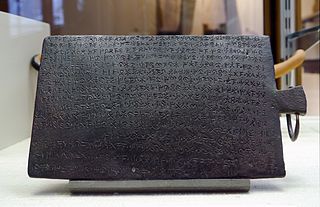 W
WThe ancient history of Cyprus shows a precocious sophistication in the neolithic era visible in settlements such as at Choirokoitia dating from the 9th millennium BC, and at Kalavassos from about 7500 BC.
 W
WThe Amathus sarcophagus is a Cypriot sarcophagus that likely held a king of Amathus. Its sides show procession scenes, and typify Cypriot, Greek, and Near Eastern styles of the mid-fifth century BCE.
 W
WAphroditus or Aphroditos was a male Aphrodite originating from Amathus on the island of Cyprus and celebrated in Athens.
 W
WArcadocypriot, or southern Achaean, was an ancient Greek dialect spoken in Arcadia in the central Peloponnese and in Cyprus. Its resemblance to Mycenaean Greek, as it is known from the Linear B corpus, suggests that Arcadocypriot is its descendant.
 W
WThe Cypriot or Cypriote syllabary is a syllabic script used in Iron Age Cyprus, from about the 11th to the 4th centuries BCE, when it was replaced by the Greek alphabet. A pioneer of that change was King Evagoras of Salamis. It is descended from the Cypro-Minoan syllabary, in turn, a variant or derivative of Linear A. Most texts using the script are in the Arcadocypriot dialect of Greek, but also one bilingual inscription was found in Amathus.
 W
WHylates was a god worshipped on the island of Cyprus who was later likened to the Greek God Apollo. His name probably derives from ὑλακτέω [ʰylaktéō] „barking“ or ὕλη [ʰýlē] „forest“, which is why Lebek calls him Apollo of the woods. He was worshipped from the 3rd century BC until the 3rd century AD.
 W
WThe Idalion Tablet is a 5th-century BCE bronze tablet from Idalium, Cyprus. It is kept in the Cabinet des médailles, Paris.
 W
WThe Kyrenia ship is the wreck of a 4th-century BC ancient Greek. It was discovered by Greek-Cypriot diving instructor Andreas Cariolou in November 1965 during a storm. Having lost the exact position Cariolou carried out more than 200 dives until he re-discovered the wreck in 1967 with the help of James Husband close to Kyrenia in Cyprus. Michael Katzev, a graduate student at the University of Pennsylvania Museum of Archaeology and Anthropology, directed a salvage expedition from 1967-69. Preservation of the ship's timbers continued during the winter of 1970. Katzev later was a co-founder of the Institute of Nautical Archaeology. The find was extensively covered in a documentary by the BBC. The ship was considered to be very well preserved with approximately 75% of it in good condition. It found a new home at the Ancient Shipwreck Museum in Kyrenia Castle, where it remains on exhibit.